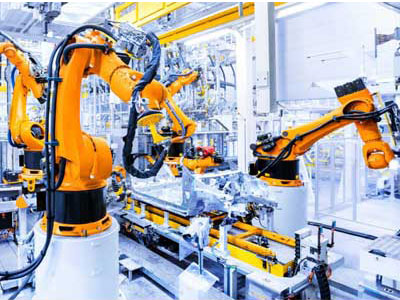Key Takeaway
IoT is integrated with industrial robots by embedding sensors and connectivity. These sensors collect real-time data from the robots during operation. This data is then transmitted to a central system through network connectivity. The system analyzes the data to monitor performance, predict maintenance needs, and optimize processes. By doing so, IoT enhances the robots’ efficiency and productivity. This integration allows robots and operators to respond to changes quickly, improving overall industrial operations. The result is smarter, more responsive robotic systems that can adapt to various manufacturing needs.
Connectivity and Data Exchange
In the realm of industrial automation, seamless connectivity and efficient data exchange are pivotal. They ensure real-time insights and operational agility across diverse systems and processes. At IndMALL, we prioritize robust solutions that optimize connectivity protocols and streamline data flow. From PLCs to HMIs and beyond, our focus is on enhancing interoperability and reliability. Explore our range of products and solutions designed to empower your industrial operations with cutting-edge connectivity and data exchange capabilities.

Real-Time Monitoring
Real-time monitoring is a game-changer in industrial robotics, thanks to IoT integration. Imagine having sensors and devices collecting and transmitting data continuously. This continuous data flow allows operators to monitor robots’ performance in real-time. Immediate data access is crucial for identifying anomalies or issues as soon as they occur, enabling swift corrective actions. For instance, if a robot’s movement deviates from its programmed path, the system can instantly alert the maintenance team. This proactive approach not only prevents potential breakdowns but also ensures smooth and uninterrupted manufacturing processes.
Moreover, real-time monitoring facilitates better decision-making. Operators can analyze current performance data to optimize operations and make adjustments on the fly. This level of responsiveness is invaluable in maintaining high efficiency and productivity. By catching issues early and addressing them promptly, real-time monitoring helps in reducing downtime and extending the lifespan of the equipment. The capability to monitor robots in real-time transforms the way industries operate, leading to more reliable and efficient production lines.
Predictive Analytics
Predictive analytics, powered by IoT, is revolutionizing industrial robotics. By analyzing vast amounts of data generated by robotic systems, predictive analytics can foresee potential failures or maintenance needs before they become critical. This foresight allows for scheduled maintenance and timely interventions, significantly reducing unexpected downtime. For example, if data shows that a robot component is wearing out faster than expected, the system can predict its failure and schedule a replacement in advance. This capability ensures continuous production and extends the lifespan of the equipment.
Additionally, predictive analytics provides insights that help in optimizing maintenance schedules and resource allocation. By understanding patterns and trends in the data, operators can make informed decisions that enhance operational efficiency. This data-driven approach not only prevents costly breakdowns but also contributes to a more sustainable and cost-effective production process. Predictive analytics, thus, plays a crucial role in maintaining the reliability and longevity of industrial robots, making it an indispensable tool in modern manufacturing.
Remote Management
Remote management, enabled by IoT, offers unparalleled flexibility in controlling industrial robots. Operators can monitor and manage robots from anywhere in the world, which is especially beneficial for industries with multiple locations or for service providers managing robots at client sites. Through IoT platforms, operators can adjust settings, update software, and troubleshoot issues without being physically present. This capability saves time and travel costs while ensuring prompt problem resolution, minimizing disruptions to the production process.
Furthermore, remote management enhances the scalability of industrial operations. Companies can deploy and manage robots across various locations with ease, ensuring consistent performance and maintenance standards. This oversight allows for quick adjustments to production schedules and operational parameters, increasing responsiveness to market demands. Remote management, therefore, not only improves operational efficiency but also provides a strategic advantage in a competitive industrial landscape. By enabling swift responses and efficient management, it supports the seamless integration of advanced robotics into modern manufacturing environments, making operations more agile and resilient.
Benefits and Challenges
The integration of IoT with industrial robots brings numerous benefits, including increased efficiency, reduced downtime, enhanced predictive maintenance, and improved overall productivity. However, it also presents certain challenges. One major challenge is data security. The interconnected nature of IoT systems makes them vulnerable to cyberattacks. Ensuring robust cybersecurity measures is crucial to protect sensitive industrial data. Another challenge is the initial cost of implementing IoT infrastructure, which can be high. Despite these challenges, the long-term benefits of IoT in industrial robotics, such as improved efficiency and cost savings, make it a worthwhile investment.
Moreover, addressing these challenges requires a strategic approach. Investing in advanced cybersecurity solutions and adopting best practices can mitigate the risks associated with data security. Additionally, considering the high initial costs, companies should evaluate the long-term ROI of IoT integration. The benefits, including enhanced operational efficiency, reduced maintenance costs, and extended equipment lifespan, often outweigh the initial investment. By overcoming these challenges, industries can harness the full potential of IoT in industrial robotics, driving innovation and growth.
These insights into real-time monitoring, predictive analytics, remote management, and the associated benefits and challenges provide a comprehensive understanding of IoT’s impact on industrial robotics. This knowledge is essential for leveraging these technologies to enhance operational efficiency and productivity in modern manufacturing.
Conclusion
IoT integration in industrial robotics revolutionizes automation by enhancing real-time monitoring, predictive maintenance, and operational efficiency. With IoT sensors and connectivity, robotics can adapt to production demands swiftly, optimize workflows, and minimize downtime through predictive analytics. This synergy ensures safer workplaces and higher productivity, paving the way for smarter, more responsive manufacturing environments.
